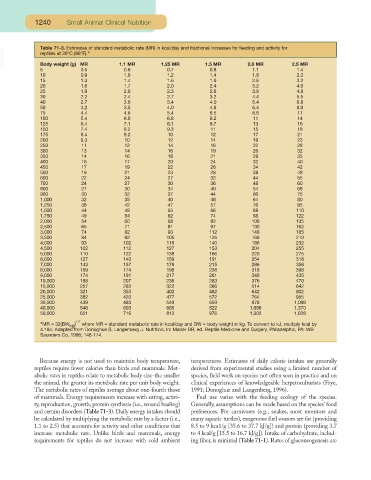Page 1190 - Small Animal Clinical Nutrition 5th Edition
P. 1190
1240 Small Animal Clinical Nutrition
Table 71-3. Estimates of standard metabolic rate (MR) in kcal/day and fractional increases for feeding and activity for
VetBooks.ir reptiles at 30°C (86°F).*
Body weight (g) MR
0.8
1.4
5 0.5 1.1 MR 1.25 MR 1.5 MR 2.0 MR 2.5 MR
1.1
0.7
0.6
10 0.9 1.0 1.2 1.4 1.8 2.3
15 1.3 1.4 1.6 1.9 2.6 3.2
20 1.6 1.7 2.0 2.4 3.2 4.0
25 1.9 2.0 2.3 2.8 3.8 4.8
30 2.2 2.4 2.7 3.2 4.4 5.5
40 2.7 3.0 3.4 4.0 5.4 6.8
50 3.2 3.5 4.0 4.8 6.4 8.0
75 4.4 4.8 5.4 6.5 8.8 11
100 5.4 6.0 6.8 8.2 11 14
125 6.4 7.1 8.1 9.7 13 16
150 7.4 8.2 9.3 11 15 18
175 8.4 9.2 10 12 17 21
200 9.3 10 12 14 19 23
250 11 12 14 16 22 28
300 13 14 16 19 26 32
350 14 16 18 21 28 35
400 16 17 20 24 32 40
450 17 19 22 26 34 42
500 19 21 23 28 38 48
600 22 24 27 32 44 55
700 24 27 30 36 48 60
800 27 30 34 40 54 68
900 30 32 37 44 60 75
1,000 32 35 40 48 64 80
1,250 38 42 47 57 76 95
1,500 44 48 55 66 88 110
1,750 49 54 62 74 98 122
2,000 54 60 68 82 108 135
2,500 65 71 81 97 130 162
3,000 74 82 93 112 148 185
3,500 84 92 105 126 168 210
4,000 93 102 116 140 186 232
4,500 102 112 127 153 204 255
5,000 110 122 138 166 220 275
6,000 127 140 159 191 254 318
7,000 143 157 179 215 286 358
8,000 159 174 198 238 318 398
9,000 174 191 217 261 348 435
10,000 188 207 236 283 376 470
15,000 257 283 322 386 514 642
20,000 321 353 402 482 642 802
25,000 382 420 477 572 764 955
30,000 439 483 549 659 878 1,098
40,000 548 603 685 822 1,096 1,370
50,000 651 716 813 976 1,302 1,628
0.77
*MR = 32(BW kg ) where MR = standard metabolic rate in kcal/day and BW = body weight in kg. To convert to kJ, multiply kcal by
4.184. Adapted from Donoghue S, Langenberg J. Nutrition. In: Mader DR, ed. Reptile Medicine and Surgery. Philadelphia, PA: WB
Saunders Co, 1996; 148-174.
Because energy is not used to maintain body temperature, temperatures. Estimates of daily calorie intakes are generally
reptiles require fewer calories than birds and mammals. Met- derived from experimental studies using a limited number of
abolic rates in reptiles relate to metabolic body size-the smaller species, field work on species not often seen in practice and on
the animal, the greater its metabolic rate per unit body weight. clinical experiences of knowledgeable herpetoculturists (Frye,
The metabolic rates of reptiles average about one-fourth those 1991; Donoghue and Langenberg, 1996).
of mammals. Energy requirements increase with eating, activi- Fuel use varies with the feeding ecology of the species.
ty, reproduction, growth, protein synthesis (i.e., wound healing) Generally, assumptions can be made based on the species’ food
and certain disorders (Table 71-3). Daily energy intakes should preferences. For carnivores (e.g., snakes, most monitors and
be calculated by multiplying the metabolic rate by a factor (i.e., many aquatic turtles), exogenous fuel sources are fat (providing
1.1 to 2.5) that accounts for activity and other conditions that 8.5 to 9 kca1/g [35.6 to 37.7 kJ/g]) and protein (providing 3.7
increase metabolic rate. Unlike birds and mammals, energy to 4 kcal/g [15.5 to 16.7 kJ/g]). Intake of carbohydrate, includ-
requirements for reptiles do not increase with cold ambient ing fiber, is minimal (Table 71-1). Rates of gluconeogenesis are

